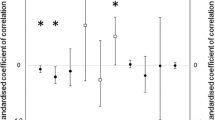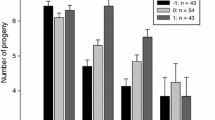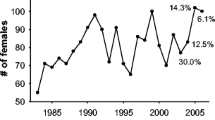Abstract
The operational sex ratio (OSR) may influence the intensity of competition for mates and mate choice and is therefore thought to be a major factor predicting the intensity and direction of sexual selection. We studied the opportunity for sexual selection, i.e., the variance in male reproductive success and the direction and intensity of sexual selection on male body mass in bank vole (Clethrionomys glareolus) enclosure populations with experimentally manipulated sex ratios. The opportunity for sexual selection was high among male-biased OSRs and decreased towards female-biased OSRs. Paradoxically, selection for large male body mass was strongest in female-biased OSRs and also considerable at intermediate OSRs, whereas at male-biased OSRs, only a weak relationship between male size and reproductive success was found. Litters in male-biased OSRs were more likely to be sired by multiple males than litters in female-biased OSRs. Our results suggest that the intensity and direction of sexual selection in males differs among different OSRs. Although the direction of sexual selection on male body mass was opposite than predicted, large body mass can be favored by sexual selection. Naturally varying OSRs may therefore contribute to maintain variation in male sexually selected traits.



Similar content being viewed by others
References
Alcock J (1994) Postinsemination associations between males and females in insects—the mate-guarding hypothesis. Annu Rev Entomol 39:1–21
Andersson M (1994) Sexual selection. Princeton University Press, New Jersey
Andersson M, Simmons LW (2006) Sexual selection and mate choice. Trends Ecol Evol 21:296
Arnold SJ (1994) Bateman principles and the measurement of sexual selection in plants and animals. Am Nat 144:S126–S149
Arnold SJ, Wade MJ (1984a) On the measurement of natural and sexual selection: applications. Evolution 38:720–734
Arnold SJ, Wade MJ (1984b) On the measurement of natural and sexual selection: theory. Evolution 38:709–719
Birkhead TR, Møller AP (1998) Sperm competition and sexual selection. Academic, New York
Bondrup-Nielsen S, Ims R (1990) Reversed sexual size dimorphism in microtines: are females larger than males or are males smaller than females? Evol Ecol 4:261
Bondrup-Nielsen S, Karlsson F (1985) Movements and spatial patterns in populations of Clethrionomys species: a review. Ann Zool Fenn 22:385–392
Bujalska G (1986) Sex ratio in an island population of Clethrionomys glareolus (Schreber, 1780). Acta Theriol 31:71–78
Clutton-Brock TH, Parker GA (1992) Potential reproductive rates and the operation of sexual selection. Q Rev Biol 67:437–456
Clutton-Brock TH, Vincent ACJ (1991) Sexual selection and the potential reproductive rates of males and females. Nature 351:58–60
Darwin C (1871) The descent of man, and selection in relation to sex. Murray, London
Dewsbury DA (1982) Ejaculate cost and male choice. Am Nat 119:601–610
Eccard JA, Ylönen H (2003) Who bears the cost of interspecific competition in an age-structured population? Ecology 84:3284–3293
Emlen S, Oring L (1977) Ecology, sexual selection, and the evolution of mating systems. Science 197:215–223
Fairbairn DJ, Wilby AE (2001) Inequality of opportunity: measuring the potential for sexual selection. Evol Ecol Res 3:667–686
Gerlach G, Musolf K (2000) Fragmentation of landscape as a cause for genetic subdivision of bank vole populations. Conserv Biol 14:1–10
Ginsberg JR, Huck UW (1989) Sperm competition in mammals. Trends Ecol Evol 4:74–79
Gockel J, Harr B, Schlötterer C, Arnolds W, Gerlach G, Tautz D (1997) Isolation and characterization of microsatellite loci from Apodemus flavicollis (Rodentia, Muridae) and Clethrionomys glareolus (Rodentia, Cricetidae). Mol Ecol 6:597–599
Gomendio M, Harcourt AH, Roldán ERS (1998) Sperm competition in mammals. In: Birkhead TR, Moller AP (eds) Sperm competition and sexual selection. Academic, New York, pp 667–751
Horne TJ, Ylönen H (1998) Heritabilities of dominance-related traits in male bank voles (Clethrionomys glareolus). Evolution 52:894–899
Jones AG, Arguello JR, Arnold SJ (2004) Molecular parentage analysis in experimental newt populations: the response of mating system measures to variation in the operational sex ratio. Am Nat 164:444–456
Jones AG, Rosenqvist G, Berglund A, Avise JC (2005) The measurement of sexual selection using Bateman’s principles: an experimental test in the sex-role-reversed pipefish Syngnathus typhle. Integr Comp Biol 45:874–884
Klemme I, Eccard JA, Ylönen H (2006) Do female bank voles (Clethrionomys glareolus) mate multiply to improve on previous mates? Behav Ecol Sociobiol 60:415–421
Kokko H, Rankin DJ (2006) Lonely hearts or sex in the city? Density-dependent effects in mating systems. Philos Trans R Soc B 361:319–334
Koskela E, Horne TJ, Mappes T, Ylonen H (1996) Does risk of small mustelid predation affect the oestrous cycle in the bank vole, Clethrionomys glareolus? Anim Behav 51:1159–1163
Kraaijeveld-Smit FJL, Ward SJ, Temple-Smit PD (2003) Paternity success and the direction of sexual selection in a field population of a semelparous marsupial, Antechinus agilis. Mol Ecol 12:475–484
Kvarnemo C, Ahnesjö I (1996) The dynamics of operational sex ratios and competition for mates. Trends Ecol Evol 11:404
Lande R, Arnold SJ (1983) The measurement of selection on correlated characters. Evolution 73:1210–1226
Mills SC, Grapputo A, Koskela E, Mappes T (2007) Quantitative measure of sexual selection with respect to the operational sex ratio: a comparison of selection indices. Proc R Soc Lond B 274:143–150
Norrdahl K, Korpimäki E (2002) Changes in population structure and reproduction during a 3-yr population cycle of voles. Oikos 96:331–345
Parker GA (1970) Sperm competition and its evolutionary consequences in the insects. Biol Rev Camb Philos Soc 45:525–567
Preston BT, Stevenson IR, Pemberton JM, Coltman DW, Wilson K (2003) Overt and covert competition in a promiscuous mammal: the importance of weaponry and testes size to male reproductive success. Proc R Soc Lond B 270:633–640
Ratkiewicz M, Borkowska A (2000) Multiple paternity in the bank vole (Clethrionomys glareolus): field and experimental data. Mamm Biol 65:6–14
Ruzzante DE, Hamilton DC, Kramer DL, Grant JWA (1996) Scaling of the variance and the quantification of resource monopolization. Behav Ecol 7:199–207
Shuster SM, Wade MJ (2003) Mating systems and strategies, 1st edn. Princeton University Press, New Jersey
Sikorski MD, Wójcik AM (1990) Mating system and reproductive success in a free-living population of the bank vole, Clethrionomys glareolus. In: Tamarin RH, Ostfeld RS, Pugh SR, Bujalska G (eds) Social systems and population cycles in voles. Birkhäuser Verlag, Basel, pp 193–202
Stockley P, Purvis A (1993) Sperm competition in mammals—a comparative-study of male roles and relative investment in sperm production. Funct Ecol 7:560–570
Thornhill R (1983) Female cryptic choice and its implications in the scorpionfly Harpobittacus nigriceps. Am Nat 122:145–154
Viitala J (1977) Social organization in cyclic subarctic populations of the voles Clethrionomys rufocanus (Sund.) and Microtus agrestis (L.). Ann Zool Fenn 14:53–93
Wade MJ (1979) Sexual selection and variance in reproductive success. Am Nat 114:742–747
Wedell N, Gage MJG, Parker GA (2002) Sperm competition, male prudence and sperm-limited females. Trends Ecol Evol 17:313–320
Ylönen H, Horne TJ, Luukkonen M (2004) Effect of birth and weaning mass on growth, survival and reproduction in the bank vole. Evol Ecol Res 6:1–10
Zeh JA, Zeh DW (1996) The evolution of polyandry I: intragenomic conflict and genetic incompatibility. Proc R Soc Lond B 263:1711–1717
Zeh JA, Zeh DW (1997) The evolution of polyandry II: post-copulatory defences against genetic incompatibility. Proc R Soc Lond B 264:69–75
Acknowledgments
We are grateful to Aira Aalto, Johanna Alakerttula, Dorota Dudek, Saana Kataja-aho, and Marko Haapakoski for assistance in the field. Elina Koivisto, Marjo Pihlaja, Sebastian Steinfartz, and three anonymous referees provided helpful comments on earlier drafts of this manuscript. Konnevesi Research Station is thanked for excellent working conditions, sauna wood, and a cozy home. This research was supported by the Academy of Finland and a grant from the Marie-Curie Foundation to I.K. The work described in this paper was conducted in accordance with current laws in Finland.
Author information
Authors and Affiliations
Corresponding author
Additional information
Communicated by K. Lindström
Rights and permissions
About this article
Cite this article
Klemme, I., Ylönen, H. & Eccard, J.A. Reproductive success of male bank voles (Clethrionomys glareolus): the effect of operational sex ratio and body size. Behav Ecol Sociobiol 61, 1911–1918 (2007). https://doi.org/10.1007/s00265-007-0431-1
Received:
Revised:
Accepted:
Published:
Issue Date:
DOI: https://doi.org/10.1007/s00265-007-0431-1




